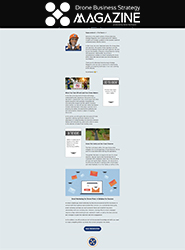
In this article, we delve into the dynamic world of drones, exploring the current state of the industry, market trends, and growth forecasts. As a leading authority in the field, we provide valuable insights and detailed analysis that will position your understanding of the drone industry at the forefront.
Whether you’re an enthusiast, a business owner, or an investor, this comprehensive article will equip you with the knowledge needed to navigate the rapidly evolving landscape of drones.
Understanding the Drone Industry
The drone industry has witnessed exponential growth in recent years, fueled by advancements in technology and the increasing demand for unmanned aerial vehicles (UAVs) across various sectors. Drones are no longer limited to military applications; they have found widespread use in fields such as aerial photography, delivery services, agriculture, infrastructure inspection, and even entertainment.
Market Size and Growth
The drone market has experienced remarkable expansion, with a steady increase in market size. According to industry reports, the global drone market was valued at $22.5 billion in 2022 and is projected to reach a staggering $66.8 billion by 2027, growing at a CAGR of 17.5% during the forecast period. This growth can be attributed to several factors, including the development of advanced drone technologies, the relaxation of regulatory frameworks, and the emergence of innovative use cases.
Key Market Trends
- Commercial Applications: Drones have revolutionized various industries, enabling cost-effective and efficient solutions. Aerial photography and videography services have soared to new heights, allowing professionals to capture breathtaking imagery for cinematography, real estate, and tourism. Additionally, delivery services have embraced drones, promising swift and seamless transportation of goods.
- Precision Agriculture: The agricultural sector has benefited significantly from the integration of drones. UAVs equipped with sophisticated sensors and imaging technologies enable farmers to monitor crop health, optimize resource allocation, and identify areas requiring attention. This targeted approach enhances productivity, minimizes waste, and contributes to sustainable farming practices.
- Infrastructure Inspection: Drones have transformed the way infrastructure inspection is conducted. These aerial platforms facilitate safer and more efficient assessments of bridges, power lines, and pipelines. Equipped with high-resolution cameras and thermal imaging capabilities, drones detect defects and anomalies, enabling timely maintenance and reducing operational costs.
- Emergency Services and Disaster Management: Drones play a crucial role in emergency response and disaster management. Equipped with specialized sensors and cameras, they aid in search and rescue missions, monitor disaster-affected areas, and assess structural damage. This technology allows for swift decision-making and helps save lives in critical situations.
US Drones by the Numbers
As of the date of this writing and according to the FAA, here are the present drone numbers for U.S. drone market:
- Drones Registered: 880,294
- Commercial Drones Registered: 349,580
- Recreational Drones Registered: 526,288
- Paper Registrations: 4,426
- Remote Pilots Certified: 325,507
- TRUST Certificates Issued: 498,217
Advancements in Drone Technology
Drone technology has witnessed remarkable advancements, leading to improved performance, enhanced capabilities, and increased safety measures. Innovations in the following areas have been instrumental in driving the growth and diversification of the drone industry:
1. Autonomous Navigation
Drone manufacturers have made significant strides in developing autonomous navigation systems. Through advanced algorithms, GPS integration, and obstacle detection sensors, drones can navigate complex environments and perform tasks with minimal human intervention. This autonomy enhances operational efficiency and opens up possibilities for a wide range of applications.
2. Payload and Sensor Integration
The integration of advanced payloads and sensors has expanded the capabilities of drones. High-resolution cameras, LiDAR (Light Detection and Ranging) systems, thermal imaging sensors, and multispectral cameras enable drones to gather precise data and generate valuable insights for industries such as agriculture, construction, and environmental monitoring.
3. Battery Technology
Battery technology has been a crucial focus area for drone manufacturers. The development of lightweight and high-capacity batteries has significantly extended flight times, allowing drones to operate for longer durations without the need for frequent recharging. This advancement has paved the way for enhanced efficiency and productivity in various applications.
4. Regulatory Environment
Governments and regulatory bodies have recognized the potential of drones and have been working towards creating frameworks to ensure their safe and responsible use. The establishment of rules and guidelines for drone operation has promoted the integration of drones into commercial and industrial settings, further boosting the growth of the industry.
Future Growth Opportunities
The drone industry is poised for continued growth, with numerous untapped opportunities on the horizon. Here are some key areas that are expected to shape the future of the drone industry:
1. Urban Air Mobility (UAM)
The concept of UAM envisions the use of drones and other aerial vehicles for urban transportation, offering an alternative mode of commuting in congested cities. Companies are actively exploring the development of air taxis and delivery drones for efficient urban logistics, and several pilot projects are already underway.
2. Artificial Intelligence (AI) Integration
The integration of AI technologies with drones holds immense potential. AI algorithms can enable drones to process real-time data, make intelligent decisions, and adapt to changing situations autonomously. This synergy between AI and drones will unlock new applications and significantly enhance their operational capabilities.
3. Drone Swarms
Collaborative drone swarms have gained attention for their ability to accomplish complex tasks collectively. By coordinating movements and sharing data, these swarms can perform large-scale aerial operations, such as search and rescue missions, environmental monitoring, and even entertainment events. The scalability and versatility of drone swarms make them an exciting area for future exploration.
The Takeaway
The drone industry has experienced remarkable growth, transforming the way we approach various sectors and unlocking new possibilities. As we look ahead, advancements in technology, expanding use cases, and favorable regulatory environments will continue to drive the industry’s upward trajectory.
Stay informed, adapt to change, and seize the opportunities presented by the thriving drone industry.
Be smart, safe, and forever fly!
If you have any questions, let us know! If you’d like to hire us, you can get more information here.
Written by: Tony Marino, MBA – FAA Certified Part 107 Commercial Drone Pilot and Chief Business Strategist at Aerial Northwest
For more information about this report visit:
https://www.researchandmarkets.com/reports/5441269/drone-services-market-by-type-platform-service
Disclaimer: The information provided in this blog post is for general informational purposes only and should not be construed as legal advice.

DRONE BUSINESS STRATEGY MAGAZINE
A free digital publication made exclusively for all small business drone pilots to them help start-up, become profitable while sustaining a competitive advantage within the drone service industry sector they opt to serve.
“If you love to fly, we’d love to have you come aboard!”
We share your information with no one. Our Privacy Policy.









Leave a Reply
Your email is always safe with us.